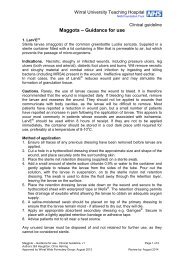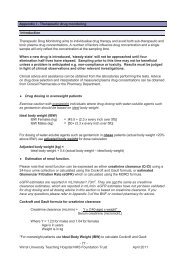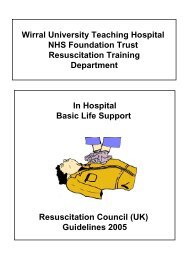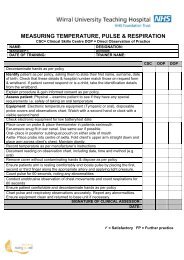Infection Prevention & Control CVC Presentation – Link Staff - Wirral ...
Infection Prevention & Control CVC Presentation – Link Staff - Wirral ...
Infection Prevention & Control CVC Presentation – Link Staff - Wirral ...
You also want an ePaper? Increase the reach of your titles
YUMPU automatically turns print PDFs into web optimized ePapers that Google loves.
<strong>Infection</strong> <strong>Prevention</strong> & <strong>Control</strong><br />
<strong>CVC</strong> <strong>Presentation</strong> – <strong>Link</strong> <strong>Staff</strong><br />
March 2010
Central Venous Catheters or<br />
<strong>CVC</strong>s<br />
• A central venous catheter (<strong>CVC</strong>) or central line is a catheter<br />
placed into a large vein in the neck (internal jugular vein),<br />
chest (subclavian vein) groin (femoral vein) or periphery<br />
e.g. arm (PICC) with the tip located in the superior vena<br />
cava of the heart.....<br />
• Dependent on its use, the catheter can be mono, bi,<br />
tri, quad or quin (1,2,3,4 or 5 !) luminal...........
Indications for Central Venous<br />
Catheter Insertion.....<br />
<strong>CVC</strong>s may be used for giving multiple<br />
infusions, medication or chemotherapy,<br />
haemodialysis, monitoring of central<br />
venous pressure (CVP), frequent blood<br />
sampling etc......
Associated Complications<br />
• Pneumothorax<br />
• Air Embolism<br />
• Haemorrhage<br />
• Arrhythmia<br />
• <strong>Infection</strong><br />
Whilst essential in the majority of cases, all invasive devices<br />
can potentially introduce bacteria into the (usually sterile)<br />
circulatory system (or bloodstream) if not inserted or cared<br />
for appropriately.......and may lead to bacteraemia
MRSA Bacteraemia<br />
Of the 16 MRSA bacteraemias<br />
identified in WUTH between<br />
April 2009<br />
and February 2010<br />
4 have been<br />
related to various types of<br />
<strong>CVC</strong>s
2 renal patients<br />
* internal jugular line (long-term; patient refused A-V fistula<br />
formation)<br />
* femoral line (emergency – unable to insert IJ at time – vessel<br />
preservation)<br />
1 haematology patient<br />
* PICC line (inserted in x-ray department - noted as difficult<br />
procedure )<br />
1 coronary care patient<br />
* femoral line (emergency insertion)
As <strong>CVC</strong> insertion may cause a number of complications, the<br />
benefit expected from their use therefore needs to<br />
outweigh the risk of those complications......<br />
the most common of which is a central lineassociated<br />
bloodstream infection (CA‐BSI) or<br />
bacteraemia....
Causes of Catheter Related-<br />
Blood Stream <strong>Infection</strong> (CR-BSI)<br />
• CR‐BSI is generally caused either by skin<br />
microorganisms at the insertion site that<br />
contaminate the catheter during insertion and<br />
migrate along the catheter track, or<br />
• Microorganisms from the hands of healthcare<br />
workers that contaminate and colonise the<br />
catheter/hubs/ports during post‐insertion care or<br />
interventions.....
EPIC 2 Recommendations<br />
1. Education of healthcare workers and patients<br />
2. Maximal sterile barrier (MSB) precautions during<br />
catheter insertion<br />
3. General asepsis<br />
4. Cutaneous (skin) antisepsis<br />
5. Selection of catheter type<br />
6. Selection of catheter insertion site<br />
7. Catheter and catheter site care<br />
8. Catheter replacement strategies and<br />
9. General principles for catheter management
Improving Patient Outcomes....<br />
• To improve patient outcomes and reduce healthcare costs, it is<br />
essential that everyone involved in caring for patients with a <strong>CVC</strong> is<br />
educated about gold standard insertion and ongoing care<br />
requirements...<br />
• Current evidence consistently demonstrates that:<br />
‣ the risk of infection declines following the standardisation of care<br />
but<br />
‣ increases when insertion and/or maintenance of <strong>CVC</strong>s is<br />
undertaken by uneducated/inexperienced healthcare workers<br />
Additional evidence demonstrates that informing/advising<br />
healthcare workers to adhere to local evidence‐based <strong>CVC</strong> protocols<br />
can decrease the risk to patients of CR‐BSI......and save a life ......
Associated Risks-Summary<br />
Failure to control healthcare‐associated infections<br />
(HCAIs) and hospital acquired infections (HAIs) can<br />
have the following consequences:<br />
• Complaints, litigation and adverse publicity<br />
• Increased costs associated with treatment of avoidable<br />
infections (approx £6,829 per patient ‐ NAO Report 2004)<br />
• Increased morbidity and mortality amongst affected<br />
patients.........<br />
• Failure to achieve MRSA bacteraemia targets
WIVAG Initiative to Improve Central Venous<br />
Catheter (<strong>CVC</strong>) Care<br />
Trust-Wide<br />
As part of a MONITOR directive to improve<br />
central venous catheter (<strong>CVC</strong>) care<br />
throughout the Trust, the <strong>Wirral</strong><br />
Intravenous Access Group (WIVAG) were<br />
charged with leading a project to<br />
comprehensively address this issue....
A WIVAG sub-group was established and the<br />
project focused on 3 main aspects:<br />
1. Optimising aseptic technique in terms of<br />
insertion and ongoing care<br />
2. Improving documentation and ‘traceability’<br />
3. Reviewing and revising Trust guidelines
In order to accomplish this, several new<br />
‘tools’ have been introduced:<br />
a. Customised <strong>CVC</strong> Insertion Pack<br />
b. PCIS noting (to enable monitoring, support<br />
and surveillance)<br />
c. <strong>CVC</strong> Care Pathway/Guidelines (detailing<br />
insertion, ongoing care and removal etc.)
Why use a <strong>CVC</strong> Insertion Tray?<br />
Because it contains MSB equipment!<br />
• EPIC 2 states that using MSB equipment has been found to:<br />
‣ decrease transmission of microorganisms<br />
‣ delay colonisation and<br />
‣ reduce the rate of hospital acquired infections (HAIs)<br />
• EPIC 2 evidence supports using MSB equipment during routine<br />
insertion of a <strong>CVC</strong> to minimise the risk of infection.......<br />
• Given the relatively low cost of the <strong>CVC</strong> insertion tray and the high<br />
cost of bacteraemia, it is highly probable that this initiative will prove<br />
to be a cost‐effective or even a cost‐saving intervention for the<br />
Organisation whilst improving patient safety....
How our <strong>Link</strong> <strong>Staff</strong> Can Help (1)...<br />
• Promote Cutaneous Antisepsis: micro‐organisms that colonise the skin<br />
surrounding the <strong>CVC</strong> insertion site and catheter hubs are the cause of most<br />
CR‐BSIs. Skin cleansing/antisepsis of the insertion site using 2%<br />
chlorhexidine/70% alcohol is therefore one of the most important<br />
measures for preventing bacteraemia . Chloraprep is included within the<br />
new <strong>CVC</strong> pack.... Make sure Inserter allows this to dry as DRY TIME = KILL<br />
TIME !<br />
• Use HII No 1a ‐ on insertion !<br />
• Ensure PCIS Entry (1): advise Inserter to enter details onto PCIS database;<br />
daily mailerbot report is generated and alerts core group of staff – provides<br />
tracking/assessment capability and ongoing support service for ward staff<br />
• Ensure Ongoing Catheter and Catheter Site Care: safe maintenance of a<br />
<strong>CVC</strong> and relevant care of the insertion site are essential components of a<br />
comprehensive strategy for preventing <strong>CVC</strong> related bacteraemias...so.......
How our <strong>Link</strong> <strong>Staff</strong> Can Help (2).....<br />
• Use <strong>CVC</strong> Care Pathway – includes <strong>CVC</strong> guidelines,<br />
instructions for daily assessment, site monitoring<br />
(RAID/VESS), care of exit site/dressing, hubs/ports etc.<br />
Inserter completes page 1 and nursing staff complete<br />
relevant sections each shift<br />
• Use HII No 1b daily<br />
• PCIS Entry (2) – when decision to remove <strong>CVC</strong> made by<br />
medical staff, nursing staff responsible for removing<br />
entry from PCIS system<br />
• Exit Site Care – nursing staff discontinue <strong>CVC</strong> Care<br />
Pathway only when exit site is fully healed
How to Access PCIS Central Line (<strong>CVC</strong>)<br />
Documentation –Ward Based <strong>Staff</strong><br />
Medical staff<br />
• Select patient<br />
• Select ‘Master Guide’<br />
• Select ‘Central Line’<br />
• Central line insertion screen will<br />
be displayed<br />
Here you can select:<br />
• Insertion/line/site information<br />
• Removal<br />
• Documented in error or<br />
• Delete entry - flagged as ‘removed<br />
in error’<br />
• Follow on-screen instructions<br />
Nursing <strong>Staff</strong><br />
• Select patient<br />
• Select ‘Master Guide’<br />
• Select ‘Central Line Removal’<br />
or<br />
• Delete entry - flagged as<br />
‘removed in error’<br />
• Follow on-screen instructions
What do you need to<br />
remember ????<br />
Your Ps and Qs !!!
Central Line (<strong>CVC</strong>) Placement Trays<br />
WUTH Best Practice Guide to Insertion and<br />
Ongoing Care<br />
Know Your P’s and Q’s !<br />
1. Pick up a Pack (and sign for it ‐ if obtained from CEL)<br />
2. Pick up a Pathway – inserter enters details on page 1<br />
3. PCIS entry – inserter enters details onto system (tracking)<br />
4. Prevent Blood Stream <strong>Infection</strong>s<br />
5. Promote patient safety –RAID/VESS<br />
6. Question <strong>CVC</strong> requirement daily<br />
7. Quality assurance every time !
Information, Education and<br />
Support.......<br />
‣ Information, education and support with this<br />
initiative is being provided by the <strong>Infection</strong> <strong>Control</strong><br />
Team and Divisional Surveillance Nurses in two<br />
distinct stages; firstly within the critical care,<br />
radiology and theatre areas and then trust‐wide (to<br />
those areas where central lines are inserted and/or<br />
utilised)......<br />
‣ Further education and training will also be provided<br />
by members of staff within the Clinical Skills Lab.....
Any Questions ???

















